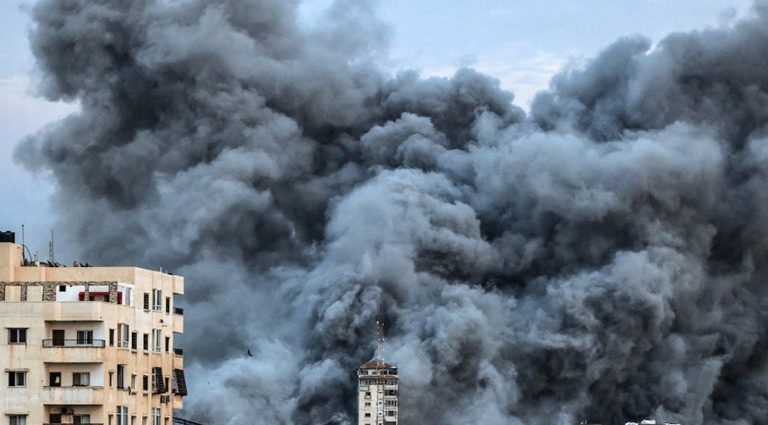After more than a month during which Israel has relentlessly bombarded then invaded Gaza with the stated aim of destroying Hamas, Gaza’s health authorities have estimated that more than 13,000 people – mainly civilians and a distressingly high proportion of those children – have been killed.
Yet it should be remembered that it was the initial attack on Israel by Hamas fighters on October 7, killing 1,200 people – again, mainly civilians, many in the most brutal manner – that led to Israel’s invasion of Gaza.
Initially, the Israel Defence Forces issued warnings to Gazan civilians to move south. But repeated airstrikes on towns in the south of Gaza have left the population fearing that there are no safe spaces left in the enclave.
Israel continues to insist, with the backing of its allies in the West, that this military operation is aimed at rooting out Hamas. They say it is the fact that Hamas embeds itself in civilian populations that is causing so many casualties.
But recently there have been signs that some Palestinian civilians are openly challenging Hamas’s authority. Associated Press reported on November 10 that angry crowds threw stones at Hamas police in one location while in another, people huddling in a UN shelter hurled insults at Hamas officials.
Political party or terror group?
Hamas was founded in Gaza in 1987 by Sheikh Ahmed Yassin, an imam, and his aide Abdel Aziz al-Rantisi. This was shortly after the beginning of the first intifada – an uprising against Israel’s occupation of the Palestinian territories.
Initially emerging as an offshoot of the Muslim Brotherhood in Egypt, Hamas later established a military wing known as the Izz al-Din al-Qassam Brigades. Its primary goal was to engage in armed resistance against Israel with the aim of liberating historic Palestine.
While there is international support for Palestinian self-determination, Hamas’s aim – spelled out in its founding charter – to destroy the state of Israel has cost it legitimacy with many who would otherwise support Palestine’s cause.
The group has effectively controlled Gaza since shortly after then-Israeli prime minister Ariel Sharon withdrew troops and settlers from Gaza in 2005. In elections in 2006, Hamas secured a majority of seats in the Palestinian Authority’s legislature and established a government.
This gave Hamas some legitimacy as far as the Palestinians in Gaza were concerned – at least temporarily.
Hamas’s early success has been ascribed to its provision of social services such as healthcare and welfare. Initially, it also seemed to be a valuable counterpoint to what was perceived as corruption within the incumbent Fatah party.
But Fatah and its Western backers found the election outcome to be unacceptable, leading to the removal of Hamas from power in the West Bank. This effectively denied Hamas the role in the PA that it believed it deserved.

A 2008 presidential election confirmed Fatah’s Mahmoud Abbas as the head of the PA. But by this stage the split between the two parties meant that while the Fatah-dominated PA governed the West Bank, Hamas was largely unchallenged in Gaza.
Vote of no confidence
But a survey undertaken by Arab Barometer, a nonpartisan research network, between September 28 and October 8, 2023 revealed dwindling confidence in Hamas (the surveys in Gaza were completed on October 6).
Asked to identify the amount of trust they had in the Hamas authorities, 44% said they had no trust at all, while 23% said they had little trust. Significantly this lack of trust was roughly uniform across age groups with those between the ages of 18-29 and those over 30 giving similar answers.
An earlier poll taken by the Washington Institute in July 2023, moreover, found that 62% of people in Gaza supported Hamas maintaining a ceasefire with Israel and 50% agreed that: “Hamas should stop calling for Israel’s destruction, and instead accept a permanent two-state solution based on the 1967 borders.”
So, given the gulf between Hamas’s aims and style of governance, how has it kept control of the enclave of 2.2 million people for so long? It’s important to remember that there have been no elections since 2006 and the average age of people in Gaza is about 18, meaning most people have not had the chance to vote for any other leadership.
Hamas has also reportedly ruled with an iron fist. Hamas has used strict and authoritarian methods of control, applying its own interpretations of strict sharia law, enforcing gender segregation in public, controlling the media, repressing any political opposition and eliminating all mechanisms of transparency and accountability.
Numerous reports have detailed human rights abuses conducted by Hamas against Palestinian civilians, including arbitrary detention, torture, punishment beatings and the death penalty.

To be fair, a report in 2018 from Human Rights Watch found that similar human rights abuse was just as common in the West Bank under the Fatah-led PA. Hamas also stands accused of harassing journalists who criticize its government.
The catastrophic Hamas attack on October 7 which has led to the deaths of so many Palestinian civilians in Gaza has eliminated any pretence of legitimacy that Hamas may ever have had in the eyes of most of the world. Indeed, the days of Hamas may be over.
But this will only increase the urgency of finding a long-term solution for Palestine, something that seems further away than ever.
Christoph Bluth, Professor of International Relations and Security, University of Bradford
This article is republished from The Conversation under a Creative Commons license. Read the original article.

